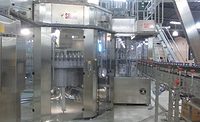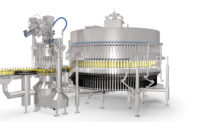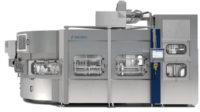Filler equipment demands flexibility, fast changeovers
New product reduces total package oxygen in beer-bottling lines

Sidel’s Combi configuration for Predis includes preform decontamination, blowing, filling and capping in one safe environment. It only requires one operator and offers a continuous production run of 165 hours. (Image courtesy of Sidel)
Like the steady drops of rain drumming on a windowpane, the filling of beverages also dictates a steady pace to keep the production line running smoothly. However, it is imperative that the correct filler is used. According to equipment manufacturing, the type of beverage and the packaging material dictate the type of filler equipment necessary for the job.
While there is a wide range of manual and semi-automatic piston-filling machines intended for different applications and purposes, manufacturers agree that filler equipment must be precise, reliable, sanitary and flexible.
“Flexibility is everything for high-speed lines now. The faster and more SKUs a plant can run keeps inventory levels much lower, so very fast changeovers are becoming more important than ever before,” BevCorp LLC’s Sales Director John Breeze says.
The Willoughby, Ohio-based, company receives many requests for remanufactured filling equipment because of the cost effectiveness and sustainability associated with them since remanufacturing is the “greener way,” he says.
Breeze adds that the design of filling valves on modern fillers has been perfected. “The machines all utilize splash guards and protective designs that do not allow debris or other hazards to enter the container,” he says.
The beverage industry typically requires a high-speed production on rotary filling equipment used to fill carbonated soft drinks (CSDs) at 1,000 containers a minute, according to Inline Filling Systems LLC, Venice, Fla. Yet, the company notes that there also is a sizeable market for slower speed inline filling machines for specialty beverages, including microbreweries producing craft beers in glass bottles that require slower speeds, e.g. 24 containers a minute.
In November 2015, Arcadia, Calif.-based Heateflex Corp. introduced its Gambrinus unit, which is designed to reduce total package oxygen (TPO) in beer-bottling lines. Installed and tested in a commercial brewery and bottling plant in the Southeast, the new technology has reduced the TPO in a bottle of beer from 70 parts per million (ppm) to 30 ppm, notes Steve Hausle, Heateflex’s vice president of sales and marketing.
Hausle explains that residual oxygen remains in the top of the bottle after conventional bottling processes, resulting in oxidation that reduces the product’s shelf life as well as its flavor and quality. Although the brewing industry has tried to reduce TPO by adding oxygen-scavenging enzymes or ascorbic acid to the bottles, Heateflex’s patented Gambrinus provides more efficient oxygen reductions, the company says.
A stainless steel in-line heater, the ASME-certified Gambrinus device injects small, precise amounts of filtered water into each beer bottle to induce correct foam characteristics and displace oxygen, it adds.
“The Gambrinus product provides the brewery industry with an all-natural alternative to added chemicals or biologicals, and reduces TPO in a beer bottle by more than 50 percent,” Hausle says. Due to its positive results, additional installations are being planned for more brewers’ bottling lines, he adds.
As health-conscious consumers demand more natural beverages, beverage producers are innovating new filling methods that protect the quality, taste and vitamin content without using preservatives or additives. Additionally, sensitive products, including juices, nectars, CSDs, isotonics, teas and liquid dairy, are predicted to grow 6 percent by 2016, notes Hünenberg, Switzerland-based Sidel.
A simpler, safer aseptic range
The first to recognize it was simpler and safer to decontaminate the preform rather than the bottle, the Sidel Predis dry preform decontamination technology launched 15 years ago, and the technology has since evolved, notes Sidel’s Predis Product Manager Arnaud Poupet.
The Sidel Matrix Predix produces as many as 60,000 bottles per hour (bph) for 0.5-liter on-the-go bottles and represents an increased output of 20 percent — with more than 90 production lines worldwide using the technology, he adds. Yet, the Sidel Matrix Combi Predis FMa is even more competitive for the same number of blow moulding stations due to the higher output per mould of as many as 2,300 bottles per mould per hour, the company says.
“The Combi configuration for Predis includes preform decontamination, blowing, filling and capping in one safe environment,” Poupet says. “It only requires one operator … and is designed to offer a continuous production run of 165 hours between two cleaning and sterilizing cycles.”
In addition to bottle filling, can filling also has experienced rapid growth, BevCorp’s Breeze says. He notes that existing machines usually need to be converted to allow new can sizes to run; however, BevCorp offers a line of rapid can filler change-over parts that reduce filler changeovers by as much as
80 percent, he says.
The future of filling equipment will require more flexible lines that are cost-effective when converting to new packages, equipment manufacturers say. “There has been a large move to single-serve packaging to give consumers more choices. Fillers that are able to fill a vast variety of products will be in demand,” Breeze says. “Many clients are now filling beer, carbonated soft drinks, water, teas and energy drinks — all on the same machines.”
Looking for a reprint of this article?
From high-res PDFs to custom plaques, order your copy today!






